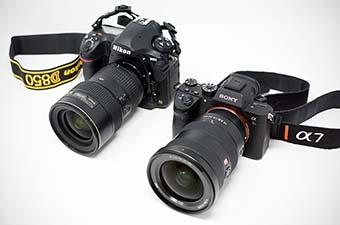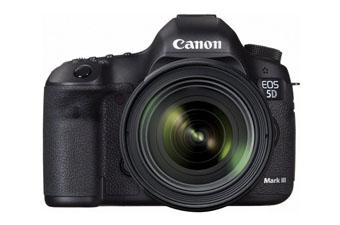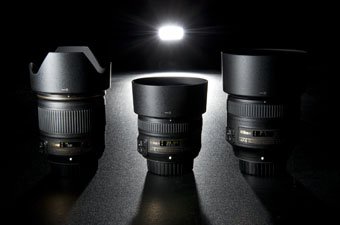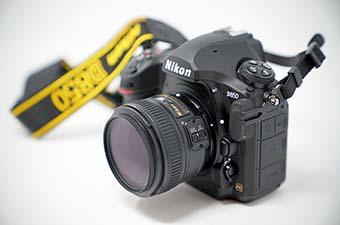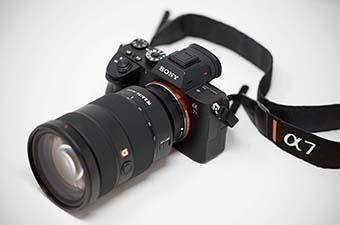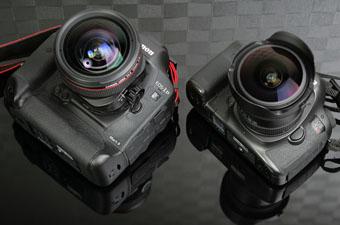The Canon EOS 6D is an extremely popular “budget” full-frame DSLR, a category that Nikon pioneered back in 2012 with the D600 (the D750 is their latest offering). The Canon 6D is a great camera on a number of fronts, including impressive image quality with a full-frame 20.2-megapixel image sensor, Full HD 1080p video, and built-in Wi-Fi and GPS. One notable sacrifice is video quality, which lags behind more expensive full-frame DSLRs due to only 11 focus points. But for still photography, the Canon 6D will help you capture professional grade images without spending a fortune.
Canon EOS 6D Kit Lenses
Canon 24-105mm f/4 IS USM ($1,999 for the kit)
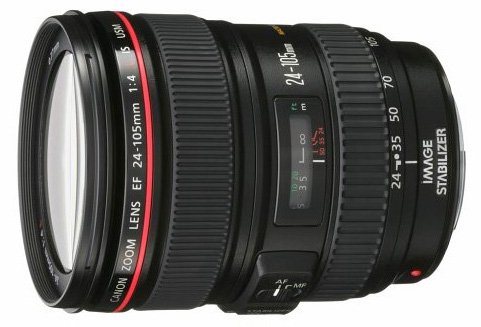 Weight: 23.7 oz.
Weight: 23.7 oz.
Maximum aperture: f/4
What we like: Versatile and sharp.
What we don't: Some distortion and softness at the ends.
The Canon 6D is bundled with the Canon 24-105mm f/4, which is a good walk-around lens and a way to enter the full-frame market while keeping the price relatively low. All things considered, this may not be a lens for top professionals but it’s sharp throughout its zoom range, has fast and accurate autofocus, and image stabilization. We also like the focal length range, which is very useful for everything from wide-angle landscape shots to portraits. You can expect some distortion at the ends and the maximum aperture of f/4 isn’t ideal for low light, but this camera/lens kit is a nice value at $2,000 for both.
See the Canon 24-105mm Kit
Wide-Angle Lenses
Canon 17-40mm f/4 L ($839)
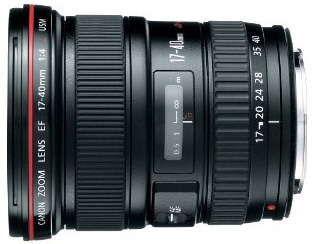 Weight: 16.8 oz.
Weight: 16.8 oz.
Maximum aperture: f/4
What we like: Inexpensive for a wide-angle zoom.
What we don't: No image stabilization.
If you want a wide-angle lens to pair with the Canon 6D without breaking the bank, the 17-40mm L is a great option. First, keep in mind that the maximum aperture is f/4 and you don’t get image stabilization, so this lens has some limitations for things like sunsets and dim indoor settings. But when shooting in decent light, it’s sharp, focuses well, and covers a variety of focal lengths from ultra-wide to a normal field of view. It’s also cheaper and lighter than other full-frame wide-angle options. It is tempting, however, to spend the extra $360 and get image stabilization with the Canon 16-35mm f/4 below.
See the Canon 17-40mm L
Canon 16-35mm f/4 L ($1,199)
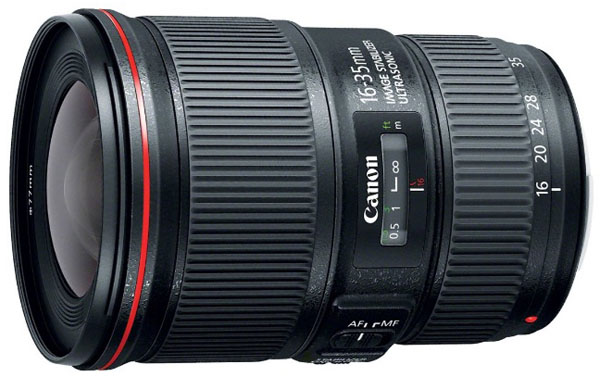 Weight: 21.7 oz.
Weight: 21.7 oz.
Maximum aperture: f/4
What we like: Sharp and comes with image stabilization.
What we don't: Distortion at the wide end.
You have two 16-35mm lens options for with the Canon 6D: the f/2.8 L version with no image stabilization, and the 16-35mm f/4 L version with image stabilization. On the 6D we prefer the cheaper f/4, which is good enough for just about everyone except those shooting fast-paced action and sports (the 6D is an unlikely choice for action and sports in the first place). This lens is sharp all the way to the corners—the f/2.8 has a tendency to be a bit soft when wide open—and Canon’s image stabilization technology performs admirably when natural light is low. And with the f/4 version being about $500 cheaper, it’s your best bet in our opinion.
See the Canon 16-35mm L
Sigma 24mm f/1.4 ($849)
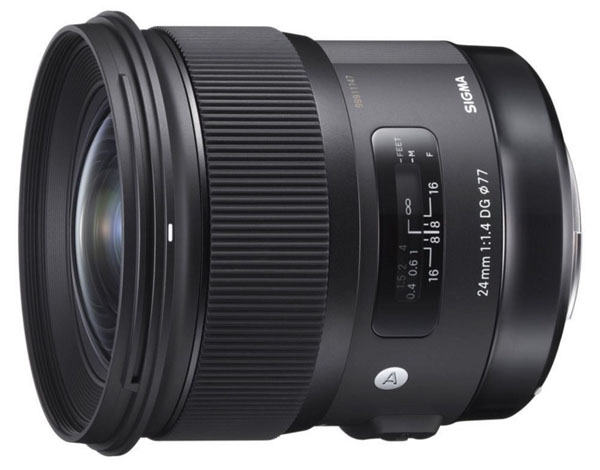 Weight: 23.5 oz.
Weight: 23.5 oz.
Maximum aperture: f/1.4
What we like: Super fast for a wide-angle lens.
What we don’t: Autofocus can be slow.
As one of our favorite third-party lens builders, Sigma brings to the table unique lenses that sometimes are cheaper and faster than Canon’s native offerings. In this case, the 24mm f/1.4 “Art” lens is exceptionally fast for a wide-angle lens, sharp, and a great value at around $900. What do you sacrifice? Autofocus can be slow and you don’t get the signature Canon build that the L Series is known for (although this Sigma lens is pretty well made). In addition, for landscape photography we prefer to shoot a little wider at 21mm instead of 24mm, but that’s being nitpicky. If you haven’t yet tried Sigma’s Art Series, which includes the 35mm f/1.4 and 50mm f/1.4, you may be pleasantly surprised with the results.
See the Sigma 24mm
Zeiss 21mm f/2.8 Distagon ($1,663)
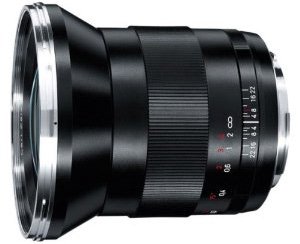 Weight: 21.2 oz.
Weight: 21.2 oz.
Maximum aperture: f/2.8
What we like: Superb optics.
What we don't: Heavy.
The Zeiss 21mm f/2.8 Distagon may be a long shot for those buying the Canon 6D, but we think it’s worthy of consideration for serious landscape photographers. If you don’t already know, Carl Zeiss makes some of the finest lenses on the planet and the manual focus 21mm Distagon has exceptional optics. Manufactured for both Canon and Nikon, the 21mm Zeiss is extremely sharp all the way to the corners with almost no distortion. It is heavy and manual focus isn’t for everyone, but the quality of this lens is unrivaled and it’s used by a number of top landscape photographers. If you’re up for something different in a wide-angle lens, take a serious look at the Zeiss 21mm.
See the Zeiss 21mm
Walk Around and Portrait Lenses
Canon 24-70mm f/4 L ($999)
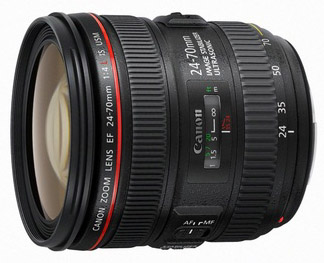 Weight: 21.6 oz.
Weight: 21.6 oz.
Maximum aperture: f/4
What we like: Literally half the price of the f/2.8 version below.
What we don't: A lot of plastic in the build.
For a “budget” full-frame DSLR like the Canon 6D we like the concept of a “budget” lens, but you won’t be disappointed by the image quality produced by the Canon 24-70mm f/4 L. Despite being one stop slower than f/2.8 version, this lens is very sharp, has minimal distortion, and is almost 7 ounces lighter. It also comes with Canon’s image stabilization technology to help reduce blur when natural light is low. The macro mode isn’t much to speak of, but this is a fine choice for those who want less distortion and weight than the 24-105mm kit lens above (personally, we like the extra 35mm reach and therefore favor the kit over buying this as a standalone lens).
See the Canon 24-70mm L
Canon 24-70mm f/2.8 L ($1,999)
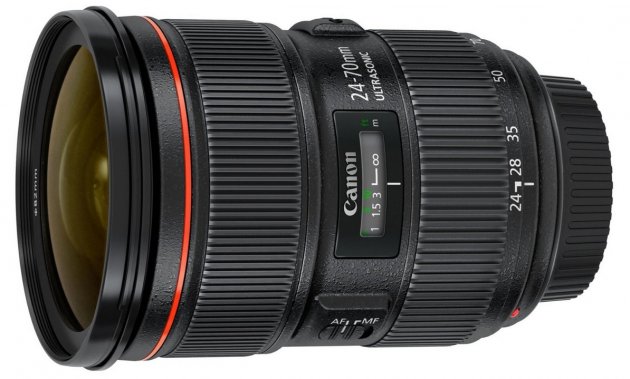 Weight: 28.3 oz.
Weight: 28.3 oz.
Maximum aperture: f/2.8
What we like: Versatility and image quality.
What we don't: Heavy and expensive.
The 24-70mm f/2.8 L is Canon’s leading mid-range zoom and a terrific lens overall. In a nutshell, this a walk-around lens suited for a professional: it’s extremely sharp, has fast and accurate autofocus, and performs well in low light with a maximum aperture of f/2.8. There are some shortcomings to consider, however: the lens is heavy at nearly 30 ounces and doesn’t come with image stabilization. It’s also more expensive than the 6D camera body itself. But compared to any of the wide-angle lenses above, the 24-70mm f/2.8 is a notable step up in quality and a great choice for the most discerning of photographers.
See the Canon 24-70mm L
Canon 40mm f/2.8 STM ($179)
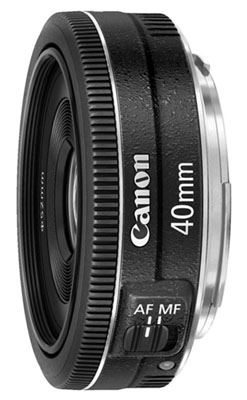 Weight: 4.6 oz.
Weight: 4.6 oz.
Maximum aperture: f/2.8
What we like: Ultra-lightweight and great optics.
What we don’t: Autofocus can be slow on occasion.
With all the pricey 35mm lenses on the market, you can adjust your focal length requirement slightly and save a ton in the process. The Canon 40mm f/2.8 is by far the lightest lens on this list but provides much better optical performance than you might expect for its size and price. For less than $200 you get good sharpness, minimal distortion, and an STM focusing motor that is great for shooting video. However, it’s not quite as fast as USM motors for stills (you can see more about Canon’s different focusing motors in our buying advice below the picks). If you need blazing fast autofocus you may want to look elsewhere, but most casual shooters and enthusiasts will love the 40mm f/2.8.
See the Canon 40mm STM
Canon 50mm f/1.4 ($349)
 Weight: 10.3 oz.
Weight: 10.3 oz.
Maximum aperture: f/1.4
What we like: Low cost, lightweight.
What we don't: Some softness at smaller apertures.
Canon makes two 50mm lenses for their full-frame cameras: the first with a maximum aperture of f/1.4, and the second with a maximum aperture of f/1.2. The latter is slightly sharper and even better in low light, but also is extremely expensive at over $1,400. Professional photographers who depend on the 50mm focal length likely will prefer the f/1.2 version, but for most people using the Canon 6D we recommend the 50mm f/1.4 L—it’s an outstanding lens and a great value. And no matter which other lenses you choose, this is a good one to have in your bag.
See the Canon 50mm
Canon 85mm f/1.8 ($369)
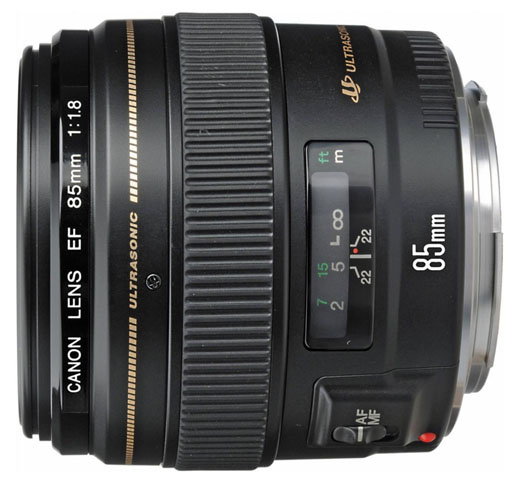 Weight: 15 oz.
Weight: 15 oz.
Maximum aperture: f/1.8
What we like: Sharp and inexpensive for a full-frame lens.
What we don’t: Great for portraits but not as versatile as other primes.
Even if 85mm isn’t your favorite focal length, the Canon 85mm f/1.8 is an attractive lens to pair with the 6D. For less than $400, you get a pro-level option to compliment the 24-105mm kit lens. It has a fast maximum aperture of f/1.8, impressive sharpness, and great autofocus. All things considered, it’s a fantastic portrait lens that will outperform the zoom options that you have or may be considering. In fact, it’s such a good value that some people use it on their APS-C cameras with a focal length equivalent of 137mm. If you don’t shoot portraits the utility of this focal length definitely goes down, but it’s a nice budget option for most photographers.
See the Canon 85mm
Telephoto Zoom Lenses
Canon 70-200mm f/4 L IS ($1,299)
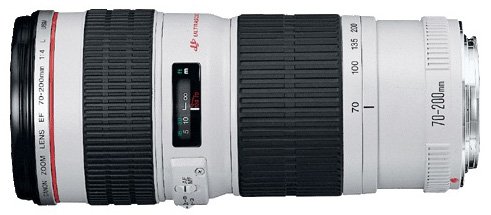 Weight: 26.9 oz.
Weight: 26.9 oz.
Maximum perture: f/4
What we like: Versatility.
What we don't: Weight.
There are two versions of Canon’s 70-200mm to choose from: the f/2.8 and the f/4. Both have excellent optics and image stabilization, with the f/2.8 being nearly twice the price and twice the weight. If you absolutely need the extra low light capability (wildlife photographers you know who you are) go with the f/2.8. Otherwise, the Canon 70-200mm f/4 L IS is a better value and much easier to carry. I’ve personally used the f/4 version on a number of trips, and despite being loud, the image stabilization works well and really helps with hand held photography in less than optimal light.
See the Canon 70-200mm L
Canon 70-300mm f/4-5.6 L IS ($1,449)
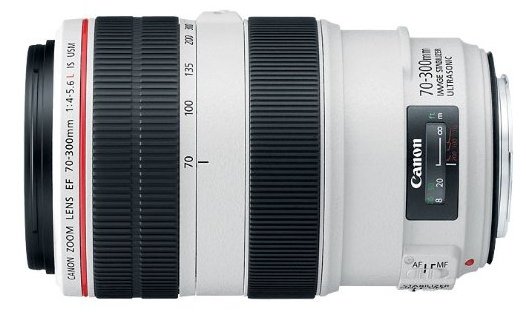 Weight: 37 oz.
Weight: 37 oz.
Maximum aperture: f/4
What we like: Versatility.
What we don't: Weight.
The Canon 70-300mm f/4 L is about $200 more than the 70-200mm f/4 above but offers an additional 100mm of zoom. It’s also about 10 ounces heavier but is extremely versatile and a great pairing with the kit lens or either of the 24-70mm lenses. For a lens of this type, images are sharp, focus is accurate and smooth, and the build feels sturdy. Low light photography will be limited by the maximum aperture of f/4, but the lens does come with image stabilization to help.
See the Canon 70-300mm L
Canon 6D Lens Comparison Table
| Lens | Price | Type | Aperture | Weight | IS | Filter |
|---|---|---|---|---|---|---|
| Canon 24-105mm f/4 IS USM | $618 | Kit | f/4 | 23.7 oz. | Yes | 77mm |
| Canon 17-40mm f/4 L | $839 | Wide angle | f/4 | 16.8 oz. | Yes | 77mm |
| Canon 16-35mm f/4 L | $1,199 | Wide angle | f/4 | 21.7 oz. | No | 77mm |
| Sigma 24mm f/1.4 | $849 | Wide angle | f1/.4 | 23.5 oz. | No | 77mm |
| Zeiss 21mm f/2.8 Distagon | $1,663 | Wide angle | f/2.8 | 21.2 oz. | No | 82mm |
| Canon 24-70mm f/4 L | $999 | Walk around | f/4 | 21.6 oz. | No | 77mm |
| Canon 24-70mm f/2.8 L | $1,999 | Walk around | f/2.8 | 28.3 oz. | No | 82mm |
| Canon 40mm f/2.8 STM | $179 | Walk around | f/2.8 | 4.6 oz. | No | 52mm |
| Canon 50mm f/1.4 | $349 | Portrait | f/1.4 | 10.3 oz. | No | 58mm |
| Canon 85mm f/1.8 | $369 | Portrait | f/1.8 | 15 oz. | No | 58mm |
| Canon 70-200mm f/4 L IS | $1,299 | Telephoto | f/4 | 26.9 oz. | Yes | 67mm |
| Canon 70-300mm f/4-5.6 L IS | $1,449 | Telephoto | f/4-5.6 | 37 oz. | Yes | 67mm |
Our Dream Camera Bag for the Canon 6D
Canon is almost begging you to buy a 24-105mm lens with the 6D: the 24-105mm f/4 L USM is $400 cheaper than by itself, and the 24-105mm f/4 STM is $300 cheaper. In this scenario, it’s tough to pay full price for a lens like the 24-70mm f/4 L, for example, and both kit lenses make excellent starting points for the 6D. Accordingly, we recommend starting with either of the two: still shooters should grab the Canon 24-105mm USM and videographers should get the Canon 24-105mm STM.
Now that you have a 24-105mm f/4, the weakness is low light performance. Accordingly, we could add the 50mm f/1.4. This “Nifty Fifty” will help you achieve the sharp photos and bokeh that are tough to come by with slower zooms. And we love the price for a full-frame lens at about $350.
Full-frame telephoto lenses are an expensive lot, but the 70-200mm f/4 IS is our favorite of the bunch. The image stabilization is on the loud side but necessary on lenses of this type, and the f/4 IS is about $800 cheaper than the f/2.8 IS. We also like the 70-200mm f/2.8 L, but that lens is quite heavy at nearly 45.8 ounces (the f/4 version weighs 26.8 ounces).
Canon’s “L” Designation
Canon’s elite full-frame lenses receive the “L” designation, including a thin red band around the barrel. Canon hasn’t been clear about what exactly “L” means, but the most common theory is that it stands for “Luxury.” Many (but not all) of these lenses are weather resistant and have high quality elements including ultra-low dispersion glass. The “L” series is dominated by lenses that are f/2.8 and faster, but the company has stretched it a bit as of late to include models like the 24-105mm f/4 USM (the kit lens sold with the 6D) and 24-70mm f/4.
All in all, Canon has done a great job marketing the L Series and consumers clearly seek lenses of this type. We wish the definition was more universal—perhaps all L lenses should be weather sealed—but it gives you a good idea of where you stand with a purchase. And don’t be afraid to buy non-L Series lenses either. The 85mm f/1.8, for example, is a terrific full-frame lens but isn’t part of the L Series.
Autofocus: USM and STM
Ultrasonic motor (USM) lenses generally are fast and accurate for still photography but have a tendency to hunt and are louder when shooting video. STM (stepping motor) lenses were designed more recently with smooth and silent video focus in mind, and you’ll notice them offered in kits with many of Canon’s APS-C cameras. Canon also has released a “Nano USM” 18-135mm f/3.5-5.6 with an EF-S mount, and we may see that technology trickle up in the near future.
The majority of full-frame lenses have a USM focusing motor, so video shooters do miss out a bit. Exceptions include the 24-105mm f/4 STM, 50mm f/1.8 STM and 40mm f/2.8 STM. If you plan on shooting video with the Canon 6D, make sure to shop for a lens that has fast autofocus. Any of the L Series lenses that are f/2.8 or faster should do a good job of shooting video on the 6D.
Third-Party Lenses
A number of third-party manufactures like Sigma, Tamron, and Tokina make lenses that are compatible with Canon full-frame cameras like the 6D. All in all, these lenses usually are cheaper than their Canon counterparts—one of their big selling points—and at least slightly inferior from an optical perspective. Common complaints often relate to slower autofocus and more softness.
We generally prefer Canon lenses but find third-party lenses most beneficial when they cover a unique focal length range or aperture (or are just flat out cheaper than the Canon options). Sigma’s relatively new “Art” series is a perfect example, which features a handful of f/1.4 prime lenses that are much less expensive than comparable Canon versions. You also can pick a zoom like the Tamron 24-70mm f/2.8 for hundreds of dollars less than the L Series 24-70mm f/2.8.
Make sure to have reasonable expectations with third-party lenses. You often get what you pay for in the lens world, and the cost savings plays itself out in the form of cheaper materials that have some effect on image and build quality. Having said that, we are all for saving money, and third-party lenses can allow you to do just that.

